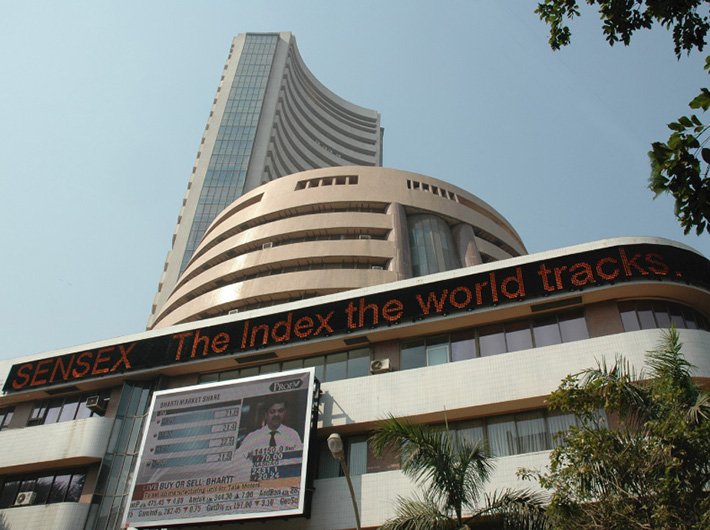The stock market surge in India has coincided with a decelaration in economic growth, whereas US growth has accelerated
Over the past two fiscal years, the Indian stock market has soared, outperforming many other major markets. Since end-December 2015, the S&P index has surged 45 percent, while the Sensex has surged 46 percent in rupee terms and 52 percent in dollar terms. This has led to a convergence in the price-earnings ratios of the Indian stock market to that of the US at a lofty level of about 26. Yet over this period the Indian and the US economies have been following different paths. So what explains the sudden convergence in stock markets?
Read: Economic Survey 2017-18
The paths of the Indian and US economies have differed in three striking ways:
- The stock market surge in India has coincided with a decelaration in economic growth, whereas US growth has accelerated.
- India’s current corporate earnings/GDP ratio has been sliding since the Global Financial Crisis, falling to just 3½ percent, while profits in the US have remained a healthy 9 percent of GDP. Moreover, the recently legislated tax cuts in the US are likely to increase post-tax earnings.
- Critically, real interest rates have diverged substantially. Rates in the US have persisted at negative levels, while those in India have risen to historically high levels. Over the period of the boom, US real rates have averaged -1.0 percent, compared to India’s 2.2 percent, a difference of 3.2 percentage points.
What, then, explains the stock market convergence? Two factors seem to be at work. First, expectations of earnings growth are much higher in India. Indeed, it was such expectations that lie at the origin of the stock market boom. In early 2016-17, signs emerged that the long slide in the corporate profits/GDP ratio might finally be coming to an end. Investors reacted to this news with alacrity, bidding up share prices in anticipation of a recovery they hoped lay just ahead. Accordingly, the ratio of prices to current earnings rose sharply.
By 2017-18 signs began to accumulate that the profit recovery was not obviously around the corner. But at that point a second factor gave the market further impetus. That factor was demonetisation.
The price of an asset is not solely determined by the expected return on that asset. It is also determined by the returns available on other assets. As pointed out in last year’s Economic Survey, the government’s campaign against illicit wealth over the past few years—exemplified by demonetisation—has in effect imposed a tax on certain activities, specifically the holding of cash, property, or gold. Cash transactions have been regulated; reporting requirements for the acquisition of gold and property have been stiffened. In addition, rupee returns to holding gold have plunged since mid-2016, turning negative since mid-2017. In addition, previously, stock prices had suffered because reporting requirements were higher on shares than purchases of other asset. But the attack on illicit wealth has helped to level the playing field.
All of this has caused investors to re-evaluate the attractiveness of stocks. Investors have accordingly reallocated their portfolios toward shares, with inflows through stock mutual funds, in particular, amounting in 2016-17 to five times their previous year’s level.
Accordingly the equity risk premium (ERP, the extra return required on shares compared with other assets) has fallen.
Does this imply that Indian P/E ratios have reached a higher “new normal”? Perhaps. It’s possible that the portfolio shift set in train by the campaign against illicit wealth will result in a sustained reduction in the ERP. But it is worth recalling that a similar assessment was made in the US after its ERP fell sharply in the late 1990s-early 2000s. A few years later, the technology bubble collapsed, then the Global Financial Crisis occurred. The ERP surged to new heights and still hasn’t reverted to its previous trough.
Beyond ERPs, sustaining current stock valuations in India also requires future earnings performance to rise to meet still-high expectations. And this outlook, in turn, depends on whether a significant economic rebound is this time well and truly around the corner.
In sum, the Indian stock market surge is different from that in advanced economies in three ways: growth momentum, level and share of profits, and critically the level of real interest rates. Low levels of the latter have been invoked to justify the high valuations in advanced economies. By that token, India’s valuations should be much lower. So, what appears to be driving India’s valuations are a fall in the ERP reflected in a massive portfolio re-allocation by savers towards equity in the wake of policy-induced reductions in the return on other assets.
But sustaining these valuations will require future growth in the economy and earnings in line with current expectations, and require the portfolio re-allocation to be semi-permanent. Otherwise, the possibility of a correction in them cannot be ruled out.
